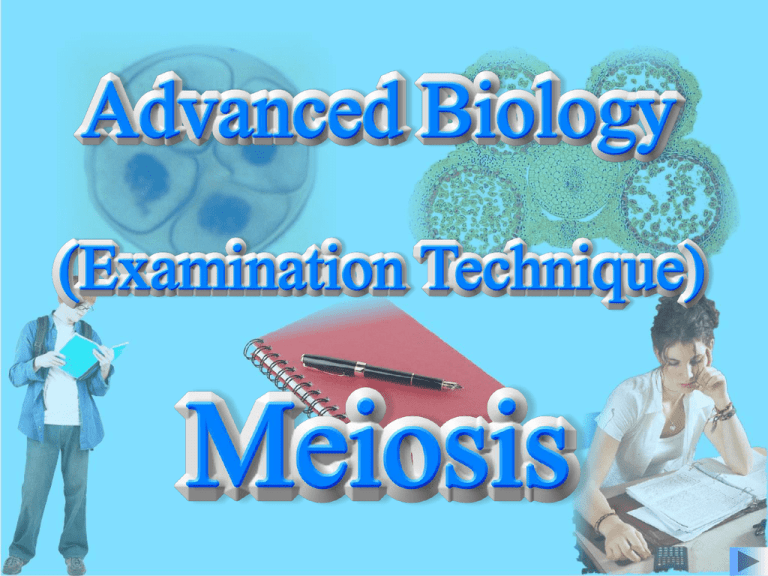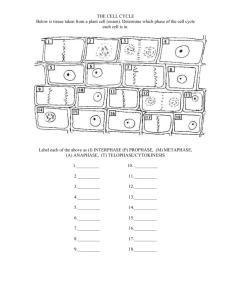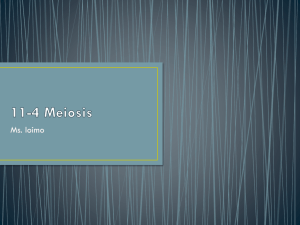MeiosisSOLUTION
advertisement

1. Distinguish between each of the following two pairs. (a) Centriole and centromere In animal cells centrioles form the spindle during cell division but plant cells ………………………………………………………………………………… do not possess centrioles. Centromeres occur in both plant and animal cells ………………………………………………………………………………… and they hold the chromatids of homologous chromosomes together. ………………………………………………………………………………… ………………………………………………………………………………… ………………………………………………………………………………(4) (b) Chiasmata formation and synapsis Chiasmata mark the point where crossingover, exchange of genetic material, ………………………………………………………………………………… occurs between homologous chromosomes. Synapsis are gaps between nerve ………………………………………………………………………………… cells which ensure the impulse travels in one direction only. ………………………………………………………………………………… ………………………………………………………………………………… ………………………………………………………………………………(4) (Total 8 marks) Examiner’s Comments 1. (a) The student has not provided enough detail to score the 4 available marks. Centrioles are made of microtubules and centromeres also provide the attachment to the spindle during cell division. 1. (b) Again, the student has not provided enough details to score the 4 available marks. The student has also made a very common error by confusing synapsis with synapses. The former is the process by which homologous chromosomes come to lie side by side during prophase I of meiosis. These two terms may be spelled similarly but if you were thinking carefully you might just wonder why a question about nerves was inserted in the middle of one clearly related to cell division. 2. The following drawing shows a cell in the process of dividing. chaismata (i)……………………………….. chromosome (ii)………………………………. centropole (iii)……………………………… spindle apparatus (iv)……………………………… centromere (v)…………………………...….. nuclear membrane (vi)……………………………... (6) (a) Name structures (i) to (vi) writing your answers on the dotted lines provided. (b) Name the type of cell division depicted in the drawing. meiotosis …………………………………………………………………………………(1) (c) What stage of cell division is shown ? Explain your reasoning. Early anaphase I because the chromosomes are pulling apart from ………………………………………………………………………………… each other. ………………………………………………………………………………… ………………………………………………………………………………(3) (d) Explain the importance of structure (i). Chiasmata mark the points where homologous chromosomes have twisted ………………………………………………………………………………… round each other exchanged portions of chromatids and separated. This ………………………………………………………………………………… cross over of genetic material mixes up alleles and leads to more genetic ………………………………………………………………………………(2) variation. (Total 12 marks) Examiner’s Comments 2. (a) There is a good deal of confusion in this student’s answer. Label (i) - to be absolutely correct the line is pointing to a single chiasma. Chiasmata is the plural of chiasma. Label (ii) - this is a chromatid not a whole chromosome. Label (iii) - there is no such term as centropole. The correct answer is centriole. There are several terms beginning with the letter ‘c’ associated with cell division you must know what each term means. Label (vi) - the cell perimeter, when the spindle apparatus is present and functioning, has to be the cell membrane as the nuclear membrane has broken down. Examiner’s Comments 2. (b) The student has either incorrectly spelt the form of cell division they intend to write, or think they have been clever because they do not know which form it is and hope that the examiner will be lenient and allow poor spelling. This will never happen in a situation such as this so make sure you know the two forms of cell division are mitosis and meiosis and what happens in each one. Examiner’s Comments 2. (c) The third mark would have been awarded if the student had been a little more precise and stated that it is the ‘homologous chromosomes’ that are being pulled apart from each other. 2. (d) A very good answer. All relevant areas of importance have been mentioned. 3. The following drawing shows a bivalent from anaphase I of meiosis. centromere (i)…….………… chromatid (ii)……..……… chiasma (iv)……………. chromosome (iii)……………. (a) Name structures (i) to (iv) writing your answers on the dotted lines provided. (4) (b) What is a bivalent? It is where two chromosomes come together. ………………………….………………………………………………………….(1) (Total 5 marks) Examiner’s Comments 3. (a) An excellent answer. All structures are correctly named and spelt. 3. (b) This answer is too vague. A bivalent is the product of two homologous chromosomes coming to lie in close association. 4. The following diagram is a diagrammatic representation of the chromosomes and other contents of a cell at metaphase I of meiosis. The diploid number is four (2n = 4) On the following diagram draw the chromosomes as they would appear during anaphase I of meiosis. (2) Label your diagram fully to show the structures involved in meiosis. (4) (Total 6 marks) Examiner’s Comments 4. The student has drawn the diagram perfectly and has clearly shown the positions of whole chromosomes at the two poles. Unfortunately the student has not labelled the cell and has therefore thrown away 4 marks. The labels could be any four from those shown below: spindle fibres chromosome centriole centromere chromatid 5. Explain two ways in which meiosis leads to genetic variation. Firstly, during Prophase I chiasmata form, crossing over occurs, and ……………………………………………………………………………… subsequently portions of homologous chromosomes andgroups of alleles are ……………………………………………………………………………… exchanged. This increases genetic variation by producing new combinations of ……………………………………………………………………………… alleles. This happens frequently so that no two gametes carry the same genetic ……………………………………………………………………………… information. Secondly, there is also random, independent assortment, of ……………………………………………………………………………… chromosomes in Anaphase I. ……………………………………………………………………………… ……………………………………………………………………………… ……………………………………………………………………………… (Total 6 marks) Examiner’s Comments 5. The student has correctly named two different processes by which meiosis leads to genetic variation but has not explained ‘independent assortment’. An explanation for random ‘independent assortment’ of chromosomes in meiosis would read: "during Metaphase I homologous chromosomes come together in pairs and subsequently segregate randomly into the daughter cells. The independent assortment of homologous chromosomes contributes to variation by producing new combinations of chromosomes and the alleles that they carry." N.B. It is the variation in the gametes (produced during meiosis) together with their subsequent random fusion that produces variation in the offspring. 6. The following photograph shows cells which have undergone cell division during the formation of pollen grains. (a) What type of cell division is responsible for the formation of pollen grains. meiosis ………………………………………………………………………………….(1) (b) (i) State two sites in Angiosperms where this type of division occurs. stamens 1.………………………………………………………………………………..… anthers 2………………………………………………………………………………..(2) (ii) State two sites in humans where this type of division occurs. ovary 1.………………………………………………………………………………..… testis 2………………………………………………………………………………..(2) (c) Explain two reasons why this type of cell division is important in the lives of angiosperms and humans. Meiosis halves the chromosome number so that when the male and female …………………………………………………………………………………… gametes unite at fertilisation the normal chromosome complement is restored. …………………………………………………………………………………… It produces haploid cells from diploid cells. …………………………………………………………………………………(2) (Total 7 marks) Examiner’s Comments 6. (a) A correct answer. Examiner’s Comments 6. (b) (i) An anther is part of a stamen so in fact the student has referenced only one structure. Another would be the ovule or pollen sac. 6. (b) (ii) Both correct answers. 6. (c) The student has made the same point twice so only scores one of the two marks available. The answer should have then made reference to the very important feature that meiosis contributes to genetic variation, as a result of crossing over and exchange of alleles between homologous chromosomes. 7. The following table contains statements about the first and second divisions of meiosis. If the statement is correct, place a tick ( ) in the appropriate space and if it is incorrect , place a cross () in the appropriate space. Statement First division Second division Random assortment of chromatids occurs during anaphase Pairing of homologous chromosomes occurs Chiasmata are formed Chromatids are separated DNA replicates before prophase (Total 5 marks) Examiner’s Comments 7. The student has completed the table as instructed in the question placing both ticks and crosses as appropriate so has not lost any marks as a result of poor examination technique. However, they have made two fundamental mistakes with the last two statements. Chromosomes separate in the first meiotic division and chromatids separate in the second meiotic division. DNA replicates once at the start of the process.







